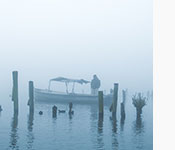Navigate in the fog
 |
Among the many critical situations that can occur on a boat, and not to be wished on anyone, is sailing in a dense bank of fog. Fortunately, in the Mediterranean, shoals almost always dissolve in a few hours, especially during the hottest hours of the day, but it is not uncommon to meet them. The enormous risks of navigating in the fog come only from poor visibility, which makes collisions and run-ins much more difficult to avoid. In the fog, in addition to skill, luck comes into play. All the technologies and calculations in the world will never be able to replace the only tool that we really cannot do without: […] |
Among the many critical situations that can occur on a boat, and not to be wished on anyone, is sailing in a dense bank of fog. Fortunately, in the Mediterranean, shoals almost always dissolve in a few hours, especially during the hottest hours of the day, but it is not uncommon to meet them.
The enormous risks of navigating in the fog come only from poor visibility, which makes collisions and run-ins much more difficult to avoid. In the fog, in addition to skill, luck comes into play. All the technologies and calculations in the world will never be able to replace the only tool that we really cannot do without: sight! The greater the density of the reef, the later we may notice an outcropping rock or a large ship suddenly appearing in the haze.
At that point there is little to do, pray and fight for survival.
What to do in foggy weather
The only really safe solution to the problem would be to avoid navigating in the fog. As soon as you enter the mist, look at the compass and stay on course for a maximum of 5 minutes. If at the end of the time the fog persists, it is advisable to follow the opposite course until the visibility is good again and wait while moving to preserve the ability to maneuver in case a ship suddenly comes out of the fog or, if possible, completely change the course.
If all this is not possible and it is necessary to cross the thick haze, this is the behavior to follow:
• Decrease the speed;
• Try to make yourself as visible as possible to other vessels' radars, using the instrument or a radar reflector first;
• Send a crew member to the bow to gain a few meters of visibility;
• Use the acoustic signals provided by the navigation code.
Acoustic signals to navigate through the fog
The Ministerial Decree 5/9/1990 n. 421 indicates the "technical characteristics for acoustic signaling devices" provided for "portable sound devices" to be kept on board:
a) Signal strength. The portable sound device must produce a sound pressure level of not less than 100 db at a distance of one meter from the device itself.
b) Construction. The portable sound device must be constructed of material resistant to corrosion in a marine environment.
c) This device is allowed to replace the bell referred to in rule 33 of Colreg 72 (for pleasure boats between 12 and 50 m in length, editor's note).
In a nutshell no, you do not have to use the bell, there are practical hand trumpets (such as those typically used in stadiums) approved, with a steel base and adequate power.
Warning: these devices should not be used randomly, there are precise sound signals to be used at sea, in conditions of reduced visibility.
• A prolonged sound at intervals (maximum 2 min.) «Mechanically propelled ship in hurry».
• two prolonged beeps with an interval of 2 seconds and repeated every 2 minutes «mechanically propelled ship in navigation, with stationary machines and no rush».
• one prolonged sound and two short ones repeated at intervals (maximum 2 min.) «Ship not steering or in difficulty in maneuvering or towing or sailing».
• one long beep and three short ones repeated at intervals (maximum 2 min.) «Last towed vessel ringing in response to the towing vessel».
• a short sound, one prolonged and one short "ship at anchor signals its position to ship approaching with risk of collision".
• five seconds of continuous bell sound at 1 minute intervals "ship at anchor signaling its position".
• three bells, rapid ringing, three bells "signaling a ship aground".
• four short beeps «pilot ship in service».
Navigating in the fog is never a pleasant experience but with the necessary precautions and the right amount of luck nothing bad happens. Having to blindly trust instrumentation and cartography could be a very useful training experience, look at here..
Also you will find the department dedicated to Acoustic Signaling devices, view here..




